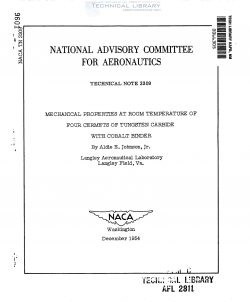naca-tn-3309
- Version
- 102 Downloads
- 485.60 KB File Size
- 1 File Count
- January 23, 2017 Create Date
- January 23, 2017 Last Updated
National Advisory Committee for Aeronautics, Technical Notes - Mechanical Properties at Room Temperature of Four Cermets of Tungsten Carbide with Cobalt Binder

The wider utilization of carbide-type cermets in applications at room
temperature where the high values of modulus of elasticity and ratio of
modulus to density could be used to advantage has been delayed because of
insufficient knowledge of the mechanical properties of the various materials,
particularly the shear and tensile properties. The available data on the
properties of cermets are limited and are principally related to specific
high—temperature applications. The present investigation of the properties
of some cermets having a tungstenpcarbide base is an extension of the inves-
tigation of the cermets having'a titaniumrcarbide base reported in refer—
ence 1. Properties of four cermets having a tungsten-carbide base for
compression, tension, and torsional shear loadings are given in the present
paper. Complete stress-strain curves to failure were obtained in addition
to values of modulus of elasticity, modulus of rigidity, Poisson‘s ratio,
ultimate strength, hardness, and density.
The sizes and shapes of the specimens are shown in figure 1; speci—
mens l, 2, and 3 are compression, tension, and shear specimens, respec—
tively. Two specimens of each of the four compositions were tested in
each of the three loadings. The specifications for the surface finish
of the specimens called for smooth grind and, in the case of the tensile
specimens, an additional requirement of no transverse scratches visible
with the naked eye and no longitudinal scratches exceeding h microinches
in depth.
Inasmuch as the carbides are very hard and brittle, the experimental
work of determining the mechanical properties, particularly the compres-
sive strength, proved to be unusually difficult. Each of the three test-
specimen shapes used in this investigation was_designed especially for_the_
material tested. The diameter and length of the test section of the
tensile specimen corresponded to the proportions of standard round tensile
specimens._ The designs necessitated special grips and fixtures for the
tension and torsion tests. The test specimens and testing techniques
were-the same as those described in reference 1; hence, they will be
described_onLy briefly in subsequent sections.
| File | Action |
|---|---|
| naca-tn-3309 Mechanical Properties at Room Temperature of Four Cermets of Tungsten Carbide with Cobalt Binder.pdf | Download |

Comment On This Post